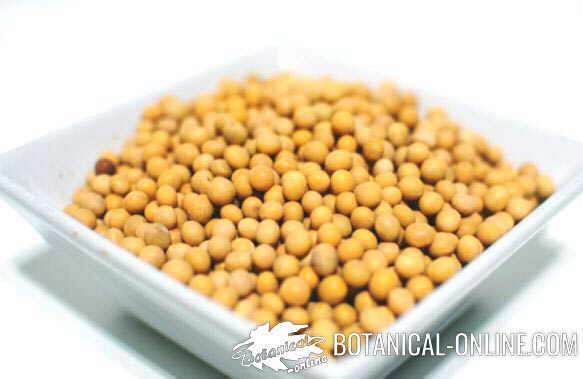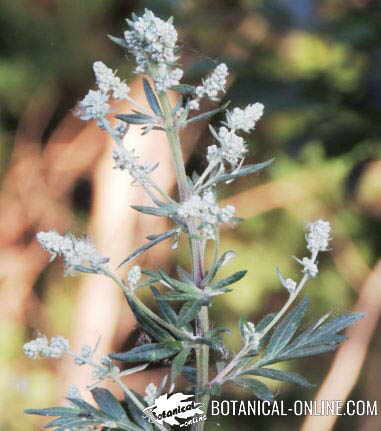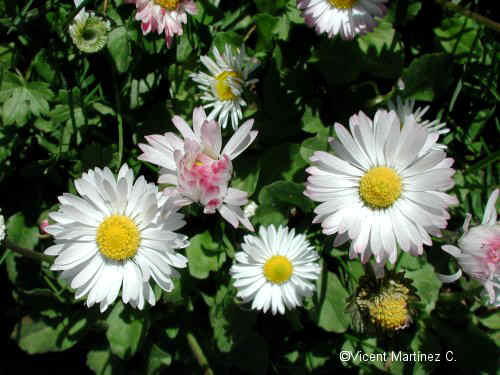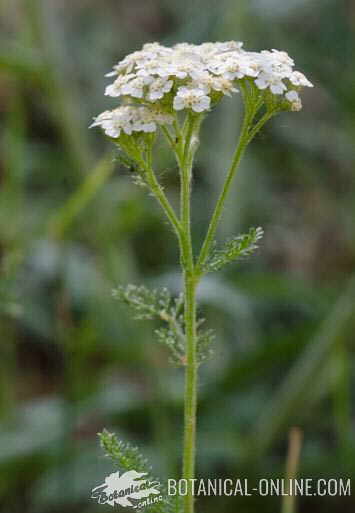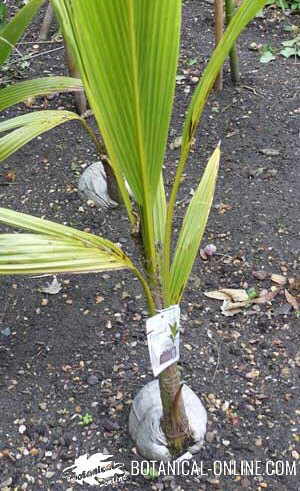Contents
What is a pine tree
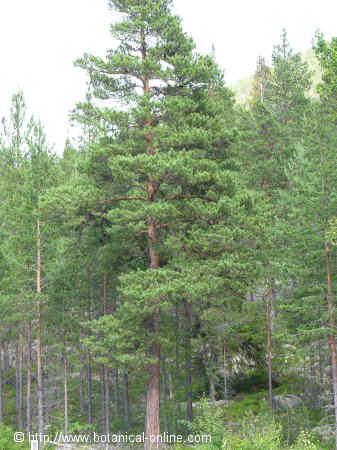
General aspect of pine tree (Pinus Sylvestris– Scots pine)
Common English name: Scots pine, Pine tree, European redwood,
Scientific name: Pinus sylvestris L. From the Latin “pinus = Pine” and “Sylvestris” = wild or savage. ”
*See: Scots pine in other languages
Family. Pinaceae
Description of pine tree
Evergreen tree of the Pinaceae family up to 40 m, but it usually reaches 25.
Erect stems, cracked gray brown bark on the bottom and red orange or reddish brown at the top and branches. Branching is complete in younger specimens, showing a well-defined pyramidal shape.
As it gets older, it loses the lower branches, leading to a naked heavy trunk with a few branches on top to give it a more ungainly aspect, and a flatter crown
Its leaves are blue-green, between 3 and 8 centimeters long, sharp and arranged in pairs. Young leaves doubly elongated and arranged in groups of 3 or 4.
Female cones almost conical pointed, brown or gray, up to 6 cm long, solitary or arranged in pairs or threes on short stalks.
Winged seeds 4 mm long, grayish black. Pollination is conducted in spring. Pineapples take about two years to mature.
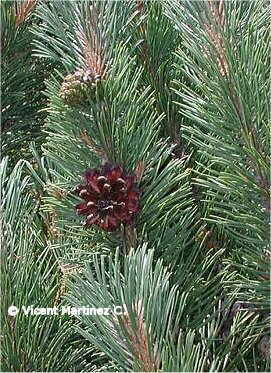
Detail of pine with leaves and cones
Pine tree habitat
Is the most widespread and abundant pine in cold areas both in Europe and in Asia.
It is a tree that grows virtually all over Europe but it has reached a special dimension in the coniferous forests of northern Europe, especially in Scandinavia where it forms pure forests.
Other times, it appears in these latitudes in spruce forests (Picea abies) or birch forests (Betula pendula) along with other trees as well known as aspen (Betula pendula) and bushes as well known as the wild rowan (Sorbus aucuparia). It extends eastward across Siberia, forming mixed forests with Siberian pine (Pinus sibirica)
It is the tree that should occupy the northernmost part of Europe as far as the edge of the trees. However, the Scandinavian taiga or boreal forest located between 50 ° and 70 ° North Latitude is now colonized by birch forests, which are considered transitional forests, since birch is a pioneer species that takes advantage of the gaps after the fires. Being a fast growing tree and lover of light, birch is able to repopulate over a period of 60 years the land that would have to be occupied by Scots pine.
In central Europe it can be found in most mountains with light soils between 600 and 1800 meters. It appears in central Europe and the Balkans with the mountain pine (Pinus mugo), in the Alps and the Carpathians with the Swiss pine or stone pine (Pinus cembra) and the Balkans with the Weymouth pine or eastern white pine (Pinus strobus)
Widely replanted in recent years throughout central Europe, southern Europe is sometimes mixed with black pine (Pinus uncinata) In some mountains it takes the place that should correspond to beech (Fagus sylvatica) and fir trees (Abies), trees that have been destroyed by man.
In the European Atlantic it has been widely introduced in countries where overcutting had put it on the verge of disappearance in Denmark, Britain, Ireland or the Netherlands. In southern Europe it reaches to almost the southernmost part of the continent, appearing on Sierra Nevada.
In Britain it was a very abundant tree until about 400 years ago, to the point that in English this tree is called “Scots pine”. This pine is the national tree of Scotland.
In the past there were great forests of pine that covered the floor of the Scottish Highlands. They were the main species of what was called the Caledonian Forest. Overgrazing and overexploitation for wood eventually reduce them to simple testimonial remains.
Varieties of Scots pine
Scots pine is a tree whose classification is very problematic since it is believed that there are over 150 varieties throughout Europe, often produced by hybridization with other pines. Among the most popular varieties are:
– Pinus sylvestris var. sylvestris: The most general and widespread variety. It appears in northern Europe to the Pacific, through Siberia. On the southern reaches North Africa and Scotland.
– Pinus sylvestris var. catalaunica: The most common variety grown in Catalonia.
– Pinus sylvestris var. pyrenaica: it grows mainly in the heart of the Pyrenees and differs from the former by its darker leaves, probably as a result of hybridization with black pine (Pinus uncinata)
– Pinus sylvestris var. lapponica: In Scandinavia and northern Russia.
– Pinus sylvestris var. hamata Steven: It is the representative variety of the Balkans and the Caucasus.
– Pinus sylvestris var. nevadensis: This variety grows in Sierra Nevada (Spain). The differences from Pinus sylvestris var. sylvestris are so small that some authors do not consider it a variety.
– Pinus sylvestris var. Iberian: Variety from Sierra de Guadarrama (Spain)
– Pinus sylvestris var. mongolica: It grows in northern China and southern Siberia.
– Pinus sylvestris var. sylvestriformis: It appears in the province of Kirin (China) from 800 meters with the Pinus sylvestris var. sylvestris
The cultivation of Scots pine
It needs plenty of watering, because it is adapted to the mountain, between 200 and 2000 meters, with rainfall around 700 mm annually. It grows fast if with the adequate water intake. (More information on cultivation)
USES OF SCOTS PINE
Timber production
Scots pine is one of the most used conifers in forestry. Large plantations of Scots pine are exploited for timber production. The inner wood or heartwood is brown or reddish brown, with pinkish streaks. It is a timber that holds fungi attacks very well and is very resistant to rot. It can not be impregnated.
Wood from the outside or sapwood is yellowish, has less grain and less resistance. It is easily impregnable.
In general, the wood of scots pine is considered a semi-heavy wood, semi-hard and very easy to work. It can be used for the manufacture of furniture, plywood, plates for wooden huts, etc.
Scots pine wood is mainly profited for the production of beams and trusses. Also for railway sleepers and beams for the mines.
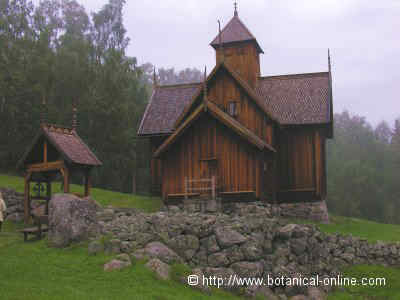
Uvdal wooden Church (Norway) You can see the dark color of the wood covered with pine tar.
Production of pine pitch
Pine tar is obtained by dry distillation of wood stumps and roots of pine. This timber is subjected to heat and pressure, thereby charcoal and tar is produced.
Pine tar has been used extensively in cold and rainy countries, mainly in Scandinavia, as a wood preservative in all types of buildings: houses, wooden churches, boats, etc.
Norwegian churches made of wood and covered with pine tar offer a very characteristic dark color.
In vessels, it does not only act as a preservative against the weather, but to waterproof them. Thus it is used to impregnate the wood deck, hull, doors, furniture and even external gear.
For its antiseptic and antimicrobial properties, pitch is used for treating skin anomalies
Christmas tree
It has been planted in large areas of the northern United States and New Zealand for timber production. In general, it has not adapted very well in the United because the climate and soil are different from those in Europe and Asia.
Many trees grow in the United States with an ugly look. However, with the due staking, they have had as great success as Christmas trees because, when young, they have an attractive pyramidal and compact aspect.
An attempt was made to introduce this tree with the same intention in Mexico, but consumers have not accepted because they do not like their hardened and sharp leaves.
Gardening
Gardening is mainly used in variety of bonsai.
![]() More information on pine tree.
More information on pine tree.


